TOYOTA FR-S 2013 Owners Manual (in English)
Manufacturer: TOYOTA, Model Year: 2013, Model line: FR-S, Model: TOYOTA FR-S 2013Pages: 412, PDF Size: 5.3 MB
Page 291 of 412
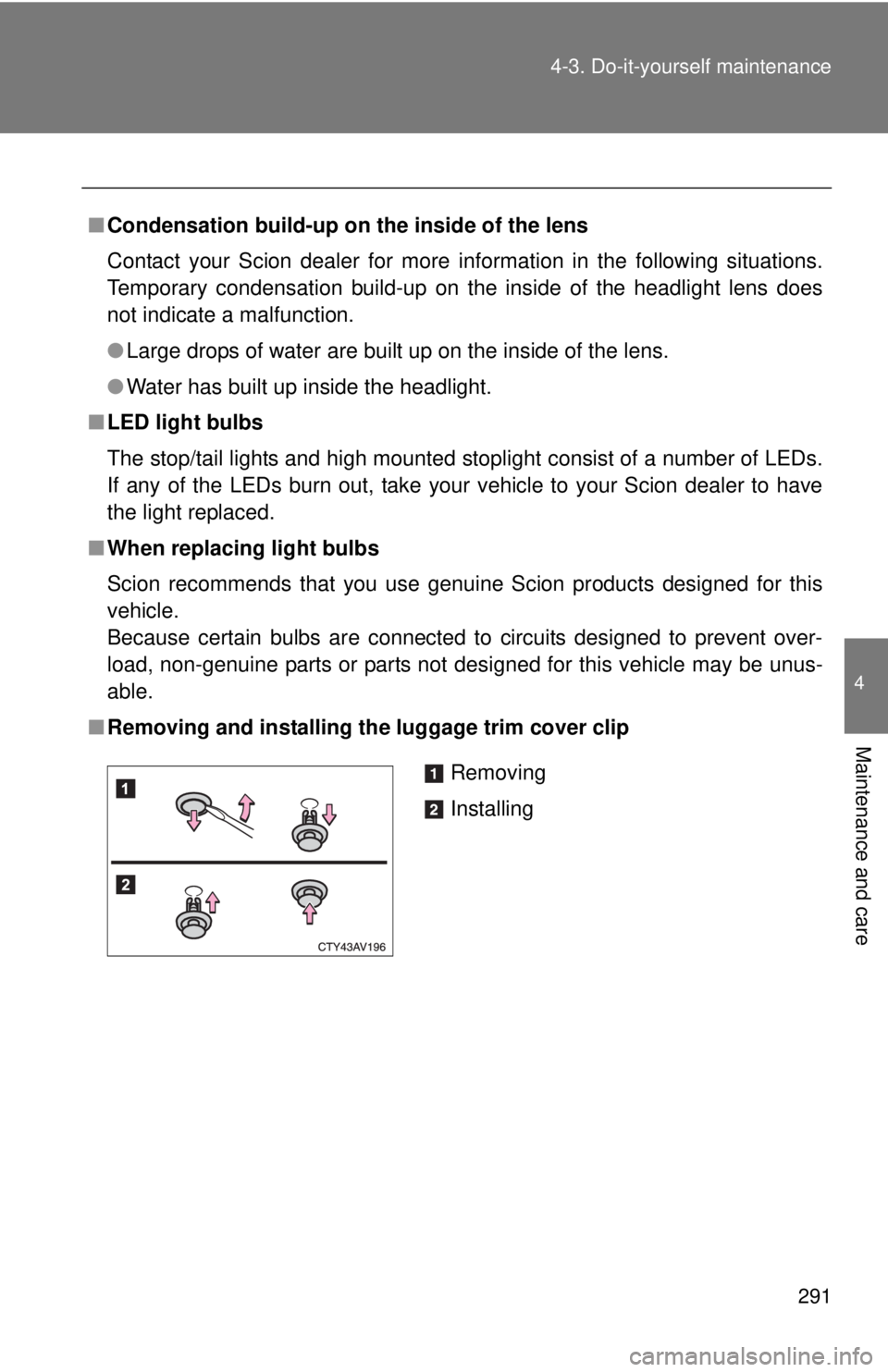
291
4-3. Do-it-yourself maintenance
4
Maintenance and care
■
Condensation build-up on th e inside of the lens
Contact your Scion dealer for more information in the following situations.
Temporary condensation build-up on the inside of the headlight lens does
not indicate a malfunction.
● Large drops of water are built up on the inside of the lens.
● Water has built up inside the headlight.
■ LED light bulbs
The stop/tail lights and high mounted stoplight consist of a number of LEDs.
If any of the LEDs burn out, take your vehicle to your Scion dealer to have
the light replaced.
■ When replacing light bulbs
Scion recommends that you use genuine Scion products designed for this
vehicle.
Because certain bulbs are connected to circuits designed to prevent over-
load, non-genuine parts or parts not designed for this vehicle may be unus-
able.
■ Removing and installing the luggage trim cover clip
Removing
Installing
Page 292 of 412
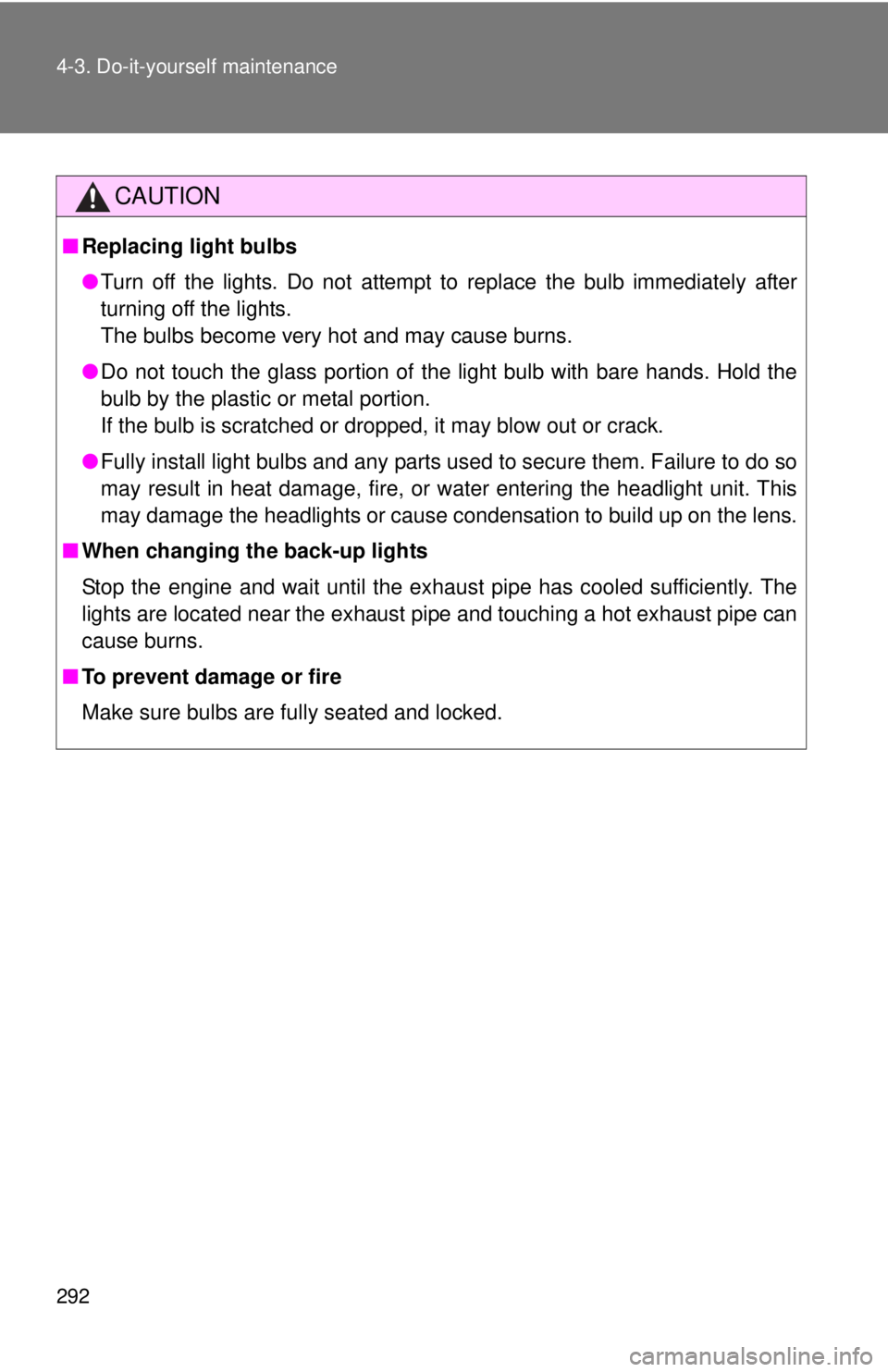
292 4-3. Do-it-yourself maintenance
CAUTION
■Replacing light bulbs
●Turn off the lights. Do not attempt to replace the bulb immediately after
turning off the lights.
The bulbs become very hot and may cause burns.
● Do not touch the glass portion of the light bulb with bare hands. Hold the
bulb by the plastic or metal portion.
If the bulb is scratched or dropped, it may blow out or crack.
● Fully install light bulbs and any parts used to secure them. Failure to do so
may result in heat damage, fire, or water entering the headlight unit. This
may damage the headlights or cause condensation to build up on the lens.
■ When changing the back-up lights
Stop the engine and wait until the exhaust pipe has cooled sufficiently. The
lights are located near the exhaust pipe and touching a hot exhaust pipe can
cause burns.
■ To prevent damage or fire
Make sure bulbs are fully seated and locked.
Page 293 of 412
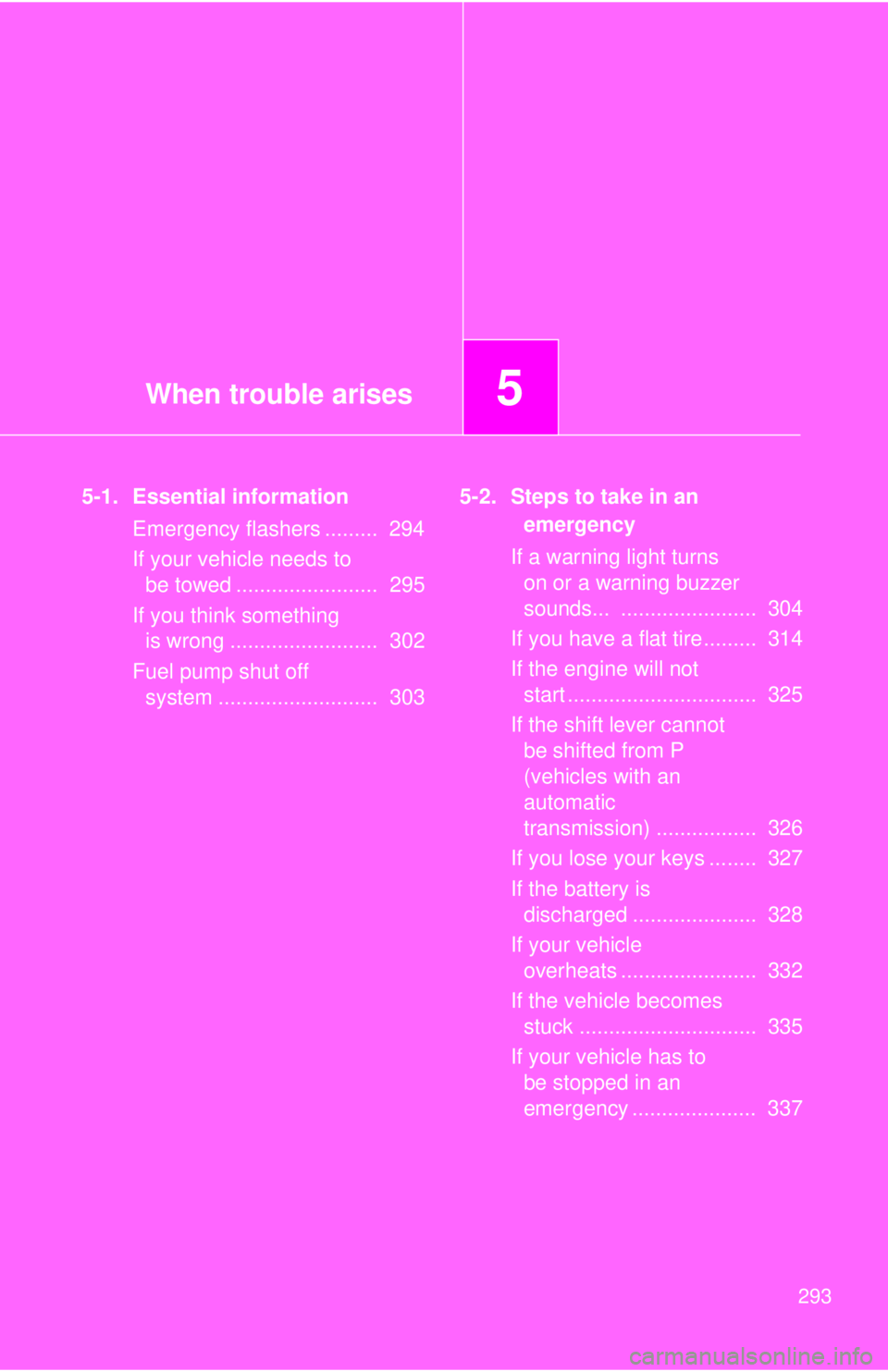
When trouble arises5
293
5-1. Essential informationEmergency flashers ......... 294
If your vehicle needs to be towed ........................ 295
If you think something is wrong ......................... 302
Fuel pump shut off system ........................... 303 5-2. Steps to take in an
emergency
If a warning light turns on or a warning buzzer
sounds... ....................... 304
If you have a flat tire......... 314
If the engine will not start ................................ 325
If the shift lever cannot be shifted from P
(vehicles with an
automatic
transmission) ................. 326
If you lose your keys ........ 327
If the battery is discharged ..................... 328
If your vehicle overheats ....................... 332
If the vehicle becomes stuck .............................. 335
If your vehicle has to be stopped in an
emergency ..................... 337
Page 294 of 412
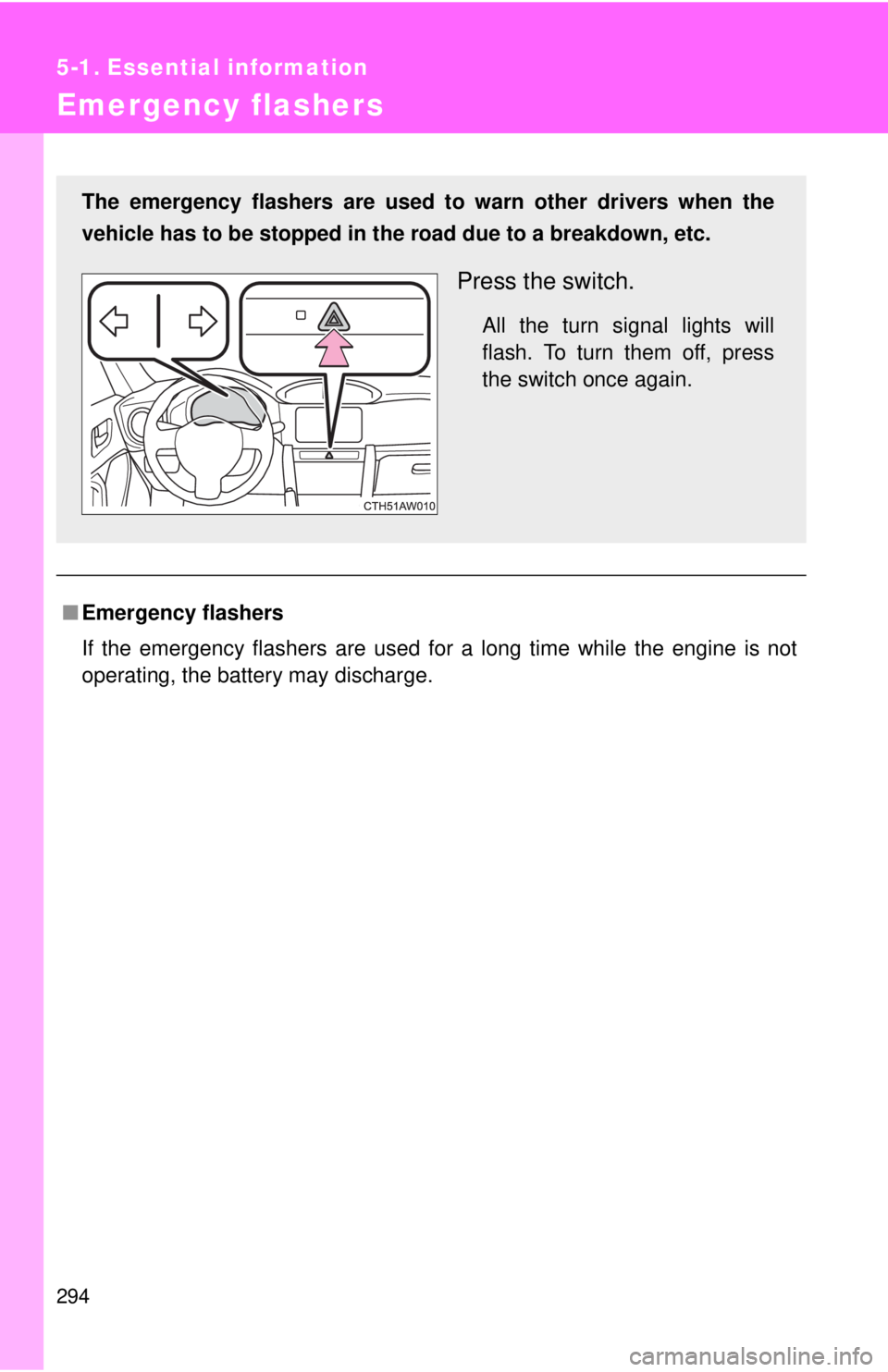
294
5-1. Essential information
Emergency flashers
■Emergency flashers
If the emergency flashers are used for a long time while the engine is not
operating, the battery may discharge.
The emergency flashers are used to warn other drivers when the
vehicle has to be stopped in the road due to a breakdown, etc.
Press the switch.
All the turn signal lights will
flash. To turn them off, press
the switch once again.
Page 295 of 412
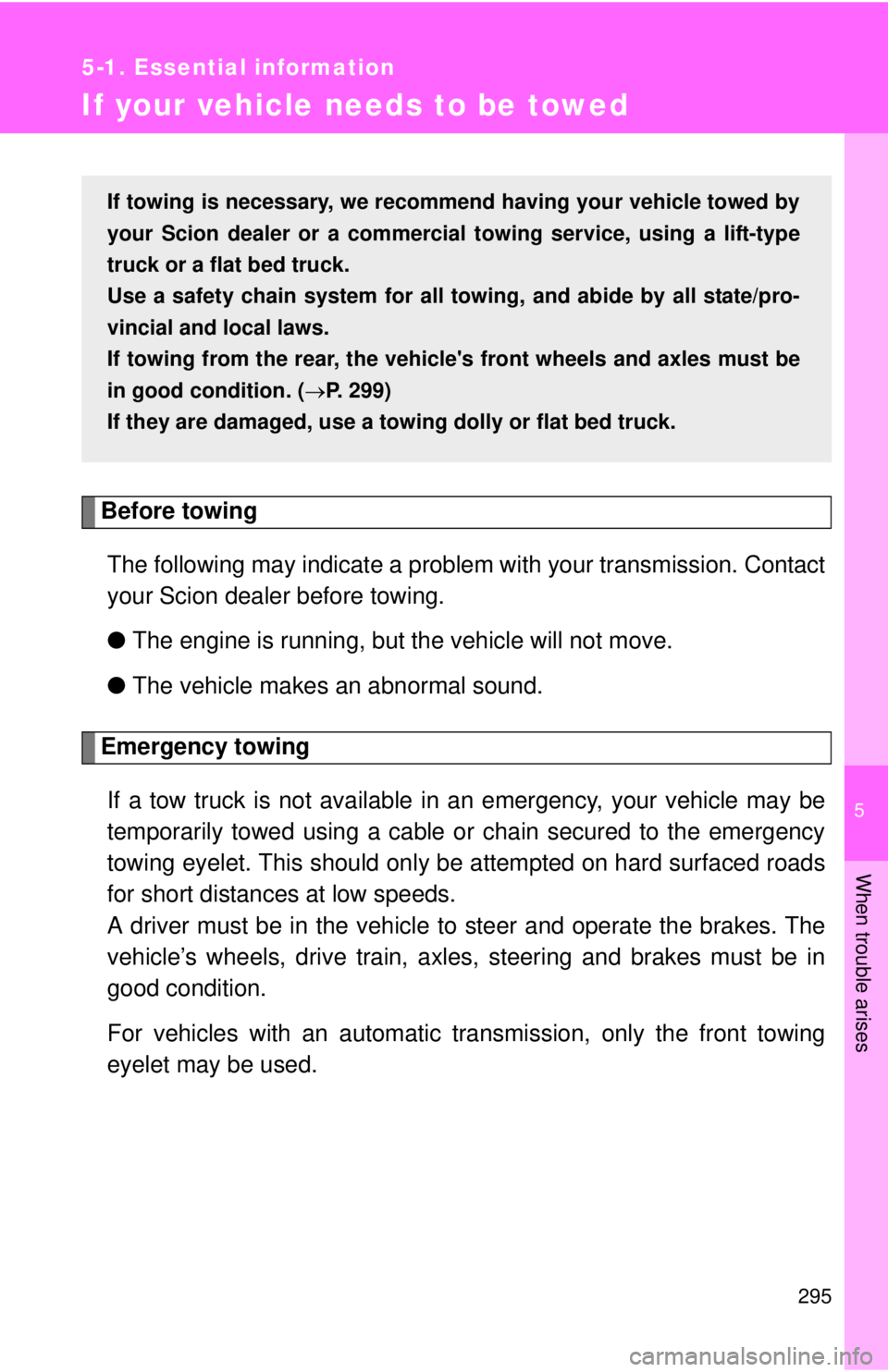
5
When trouble arises
295
5-1. Essential information
If your vehicle needs to be towed
Before towingThe following may indicate a problem with your transmission. Contact
your Scion dealer before towing.
● The engine is running, but the vehicle will not move.
● The vehicle makes an abnormal sound.
Emergency towing
If a tow truck is not available in an emergency, your vehicle may be
temporarily towed using a cable or chain secured to the emergency
towing eyelet. This should only be attempted on hard surfaced roads
for short distances at low speeds.
A driver must be in the vehicle to steer and operate the brakes. The
vehicle’s wheels, drive train, axles, steering and brakes must be in
good condition.
For vehicles with an automatic transmission, only the front towing
eyelet may be used.
If towing is necessary, we recommend having your vehicle towed by
your Scion dealer or a commercial towing service, using a lift-type
truck or a flat bed truck.
Use a safety chain system for all to wing, and abide by all state/pro-
vincial and local laws.
If towing from the rear, the vehic le's front wheels and axles must be
in good condition. (P. 299)
If they are damaged, use a towing dolly or flat bed truck.
Page 296 of 412
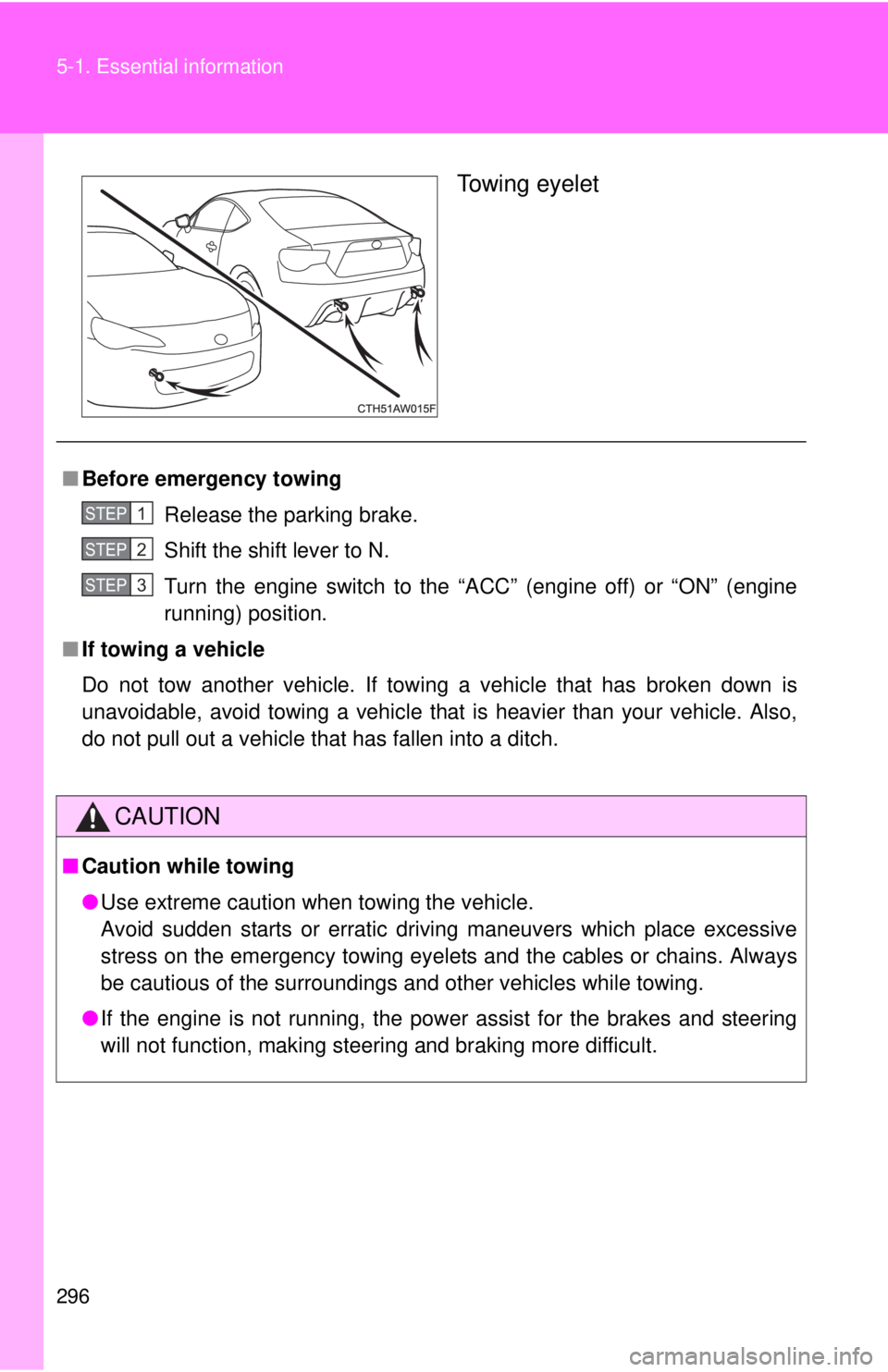
296 5-1. Essential information
Towing eyelet
■Before emergency towing
Release the parking brake.
Shift the shift lever to N.
Turn the engine switch to the “ACC” (engine off) or “ON” (engine
running) position.
■ If towing a vehicle
Do not tow another vehicle. If towing a vehicle that has broken down is
unavoidable, avoid towing a vehicle that is heavier than your vehicle. Also,
do not pull out a vehicle that has fallen into a ditch.
CAUTION
■Caution while towing
●Use extreme caution when towing the vehicle.
Avoid sudden starts or erratic driving maneuvers which place excessive
stress on the emergency towing eyelets and the cables or chains. Always
be cautious of the surroundings and other vehicles while towing.
● If the engine is not running, the power assist for the brakes and steering
will not function, making steering and braking more difficult.
STEP 1
STEP 2
STEP 3
Page 297 of 412
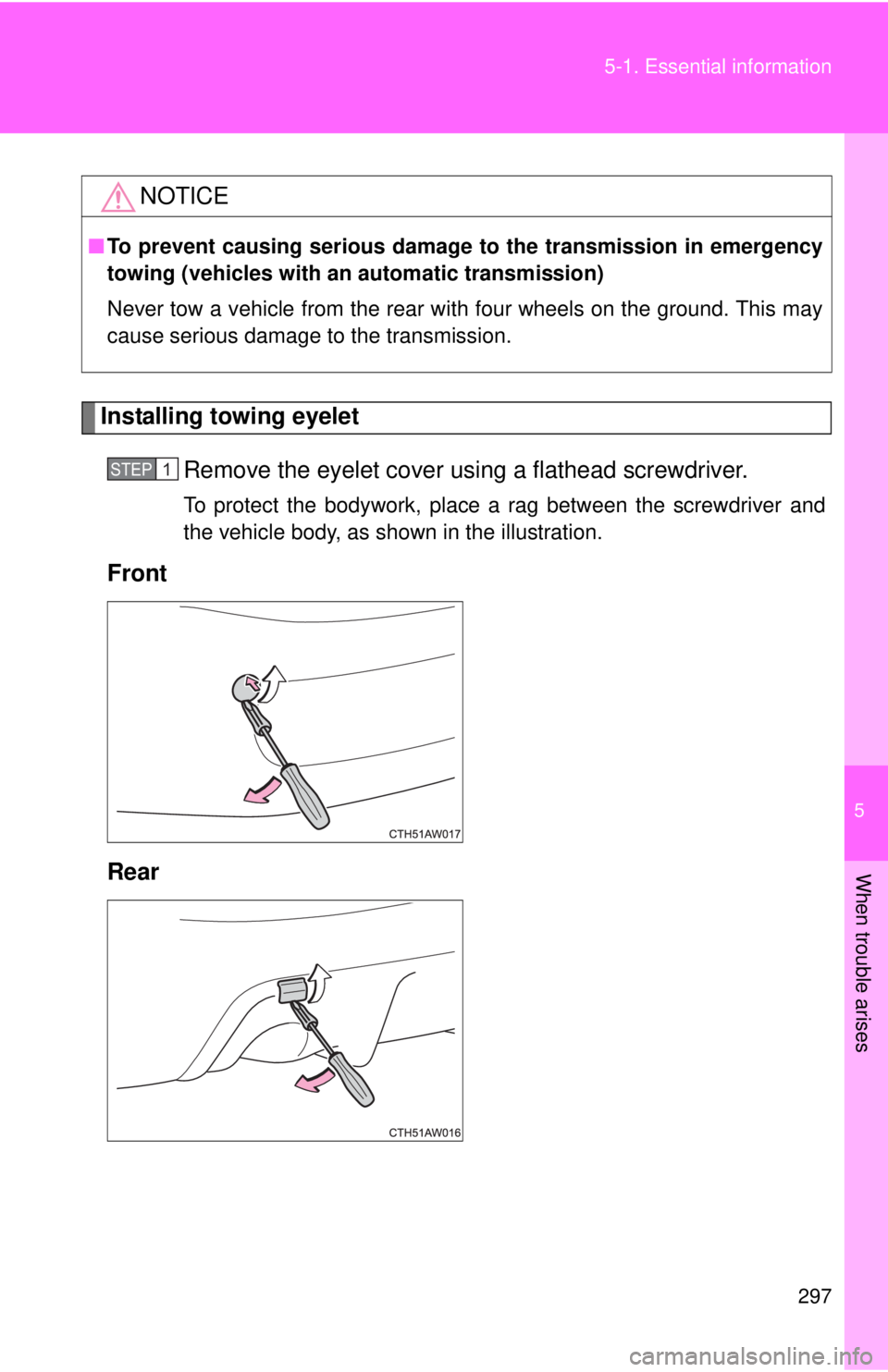
5
When trouble arises
297
5-1. Essential information
Installing towing eyelet
Remove the eyelet cover us ing a flathead screwdriver.
To protect the bodywork, place a rag between the screwdriver and
the vehicle body, as shown in the illustration.
Front
Rear
NOTICE
■To prevent causing serious damage to the transmission in emergency
towing (vehicles with an automatic transmission)
Never tow a vehicle from the rear with four wheels on the ground. This may
cause serious damage to the transmission.
STEP 1
Page 298 of 412
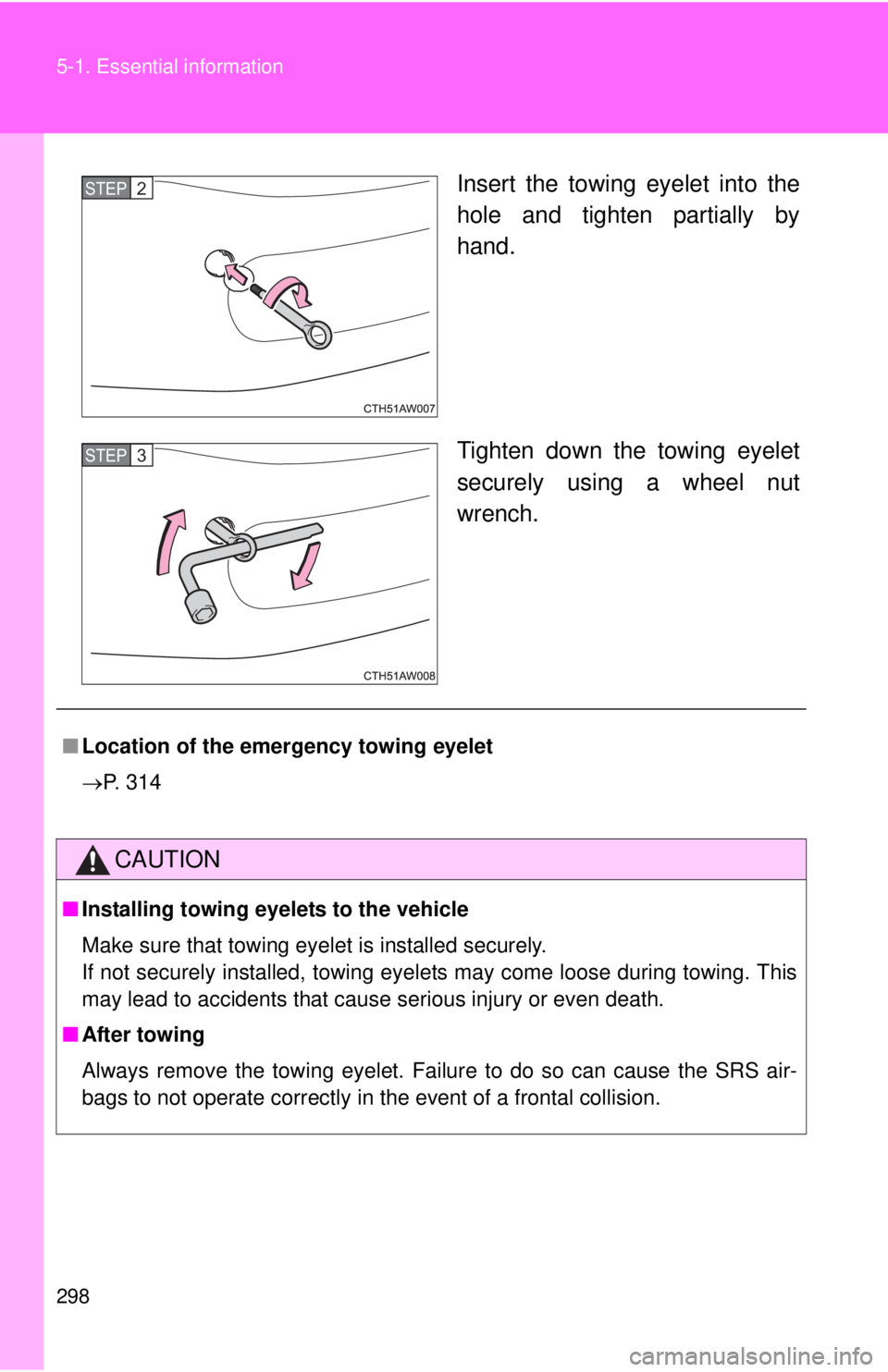
298 5-1. Essential information
Insert the towing eyelet into the
hole and tighten partially by
hand.
Tighten down the towing eyelet
securely using a wheel nut
wrench.STEP 2
STEP 3
■Location of the emer gency towing eyelet
P. 314
CAUTION
■ Installing towing eyelets to the vehicle
Make sure that towing eyelet is installed securely.
If not securely installed, towing eyelets may come loose during towing. This
may lead to accidents that cause serious injury or even death.
■ After towing
Always remove the towing eyelet. Failure to do so can cause the SRS air-
bags to not operate correctly in the event of a frontal collision.
Page 299 of 412
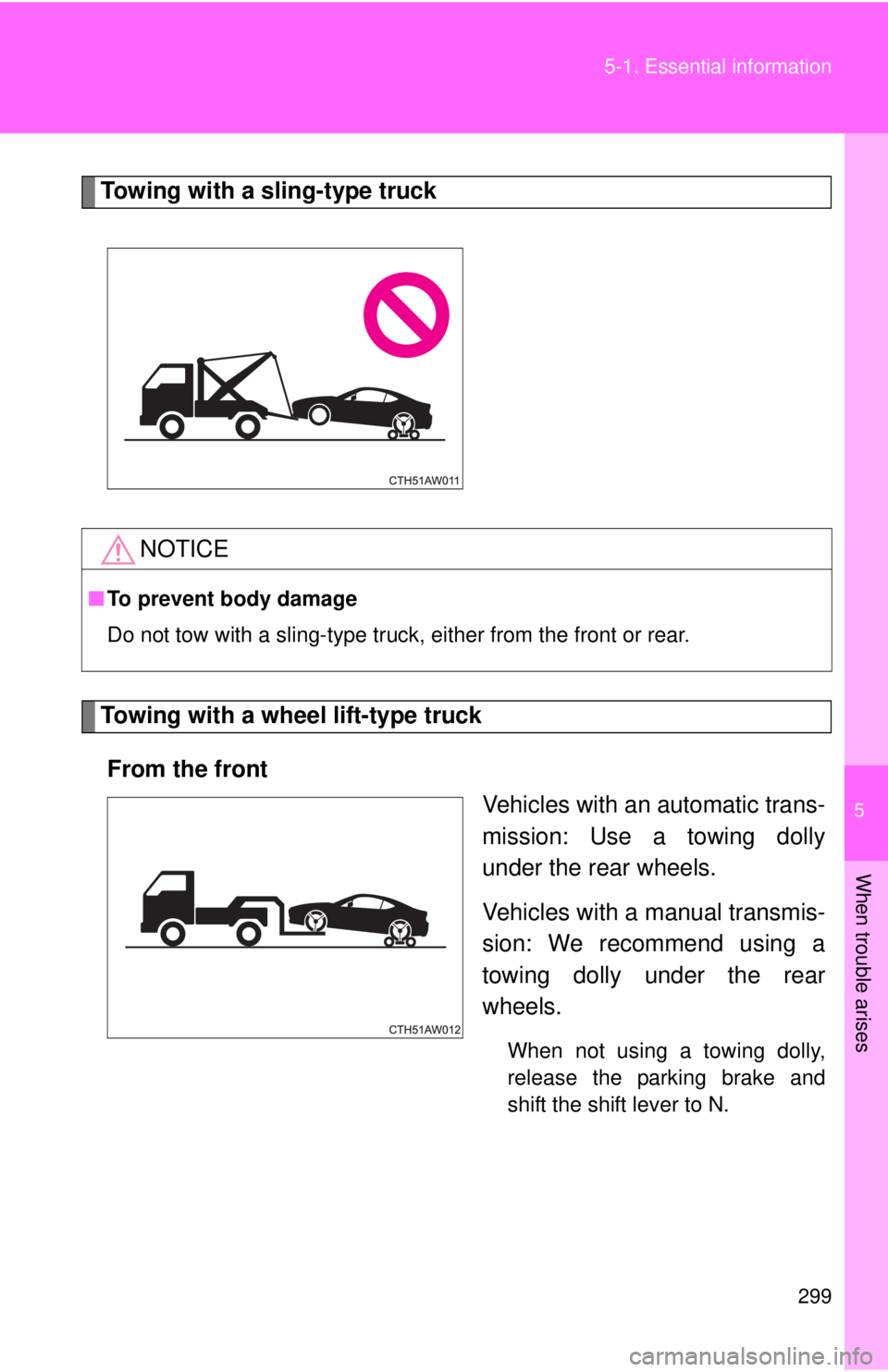
5
When trouble arises
299
5-1. Essential information
Towing with a sling-type truck
Towing with a wheel lift-type truck
From the front Vehicles with an automatic trans-
mission: Use a towing dolly
under the rear wheels.
Vehicles with a manual transmis-
sion: We recommend using a
towing dolly under the rear
wheels.
When not using a towing dolly,
release the parking brake and
shift the shift lever to N.
NOTICE
■To prevent body damage
Do not tow with a sling-type truck, either from the front or rear.
Page 300 of 412
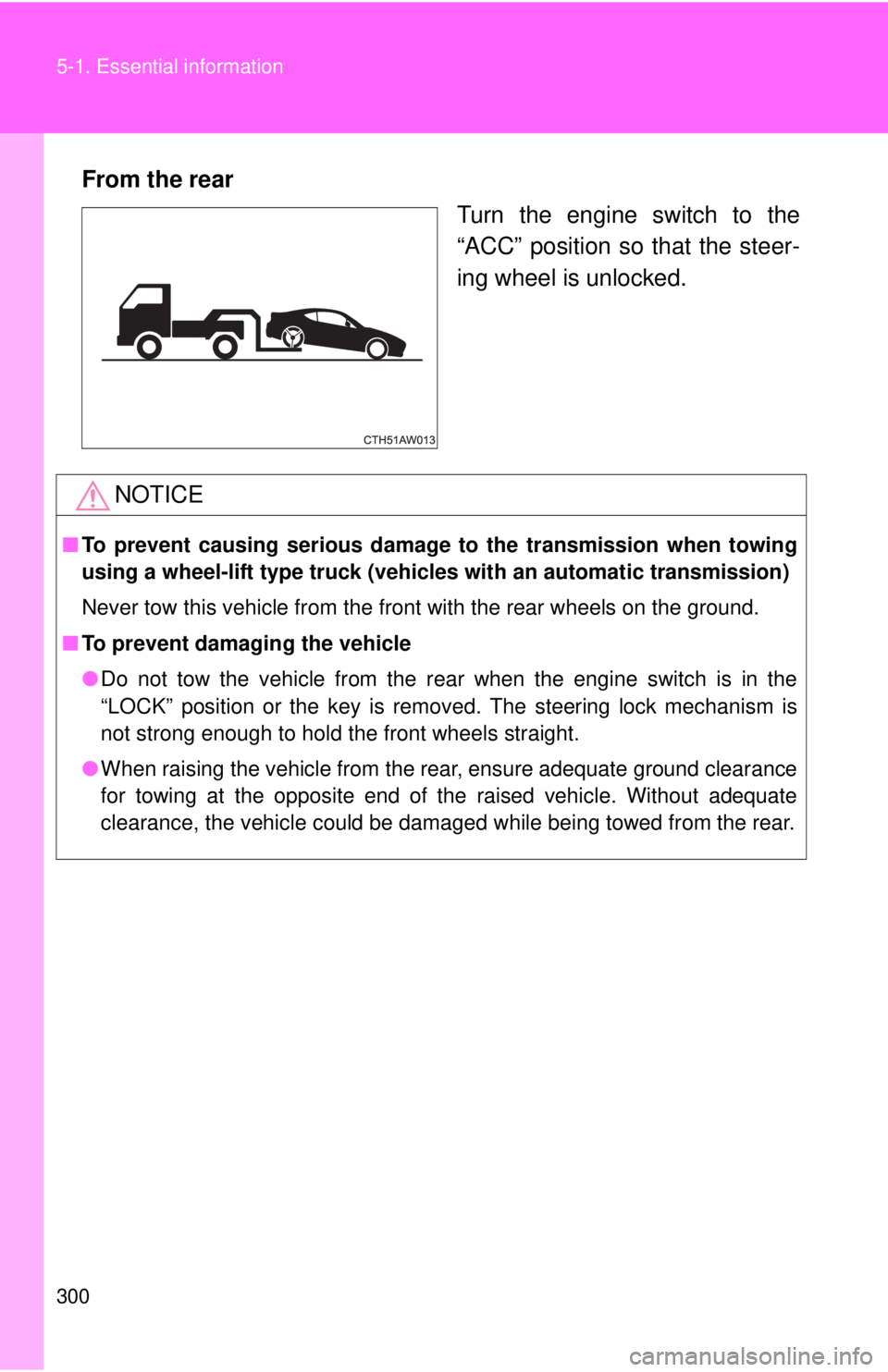
300 5-1. Essential information
From the rearTurn the engine switch to the
“ACC” position so that the steer-
ing wheel is unlocked.
NOTICE
■To prevent causing serious damage to the transmission when towing
using a wheel-lift type truck (vehic les with an automatic transmission)
Never tow this vehicle from the front with the rear wheels on the ground.
■ To prevent damaging the vehicle
●Do not tow the vehicle from the rear when the engine switch is in the
“LOCK” position or the key is removed. The steering lock mechanism is
not strong enough to hold the front wheels straight.
● When raising the vehicle from the rear, ensure adequate ground clearance
for towing at the opposite end of the raised vehicle. Without adequate
clearance, the vehicle could be damaged while being towed from the rear.